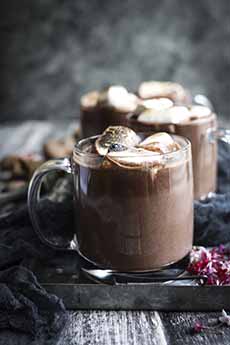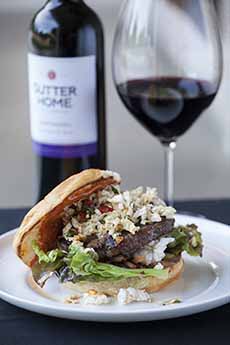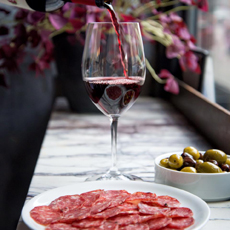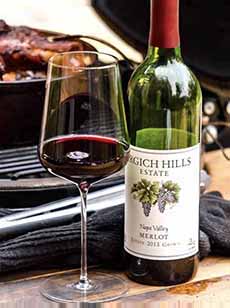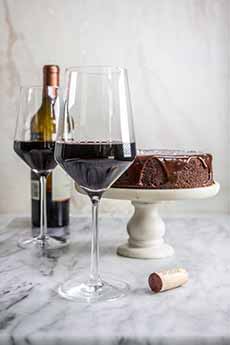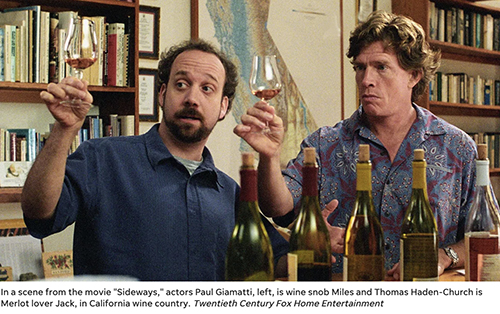RECIPE: Merlot Hot Chocolate & The History Of Merlot
|
|
National/International Merlot Day is November 7th, but that was a warm day in our neck of the woods—not an incentive to make hot chocolate. Today is different: the first snowfall of the year, with a white veil outside and the need to turn up the heat inside—and make a cup of hot chocolate. It’s the perfect opportunity to pop the cork of a bottle of Merlot: first to add to the hot chocolate mid-afternoon snack, and the rest of the bottle later at dinner. Below you’ll find: > The recipe for Merlot hot chocolate is below. > The styles and flavors of Merlot. Elsewhere on The Nibble: > The year’s 25+ red wine holidays. > Download this e-book for holiday cocktail recipes from Discover California Wines.
Merlot is one of the great grapes of Bordeaux, along with Cabernet Sauvignon and Pinot Noir. In the U.S. it’s often been passed over in favor of the first two. Today, California Merlot gets the respect it deserves, and ranks third in California red varietal sales, after Cabernet Sauvignon and red blends (by law, a wine with less than 70% of the varietal grape is called a blend)‡‡. As compared with the more tannic Cabernet Sauvignon, Merlot is soft and approachable when young, with a luscious red-fruit character. It pairs especially well with: RECIPE: MERLOT HOT CHOCOLATE You can use any red wine in this recipe, but stick to the medium-body ones (Barbera, Beaujolais, Grenache, Merlot, Pinot Noir, Rioja Crianza, Valpolicella). You can serve this Vin Chaud Chocolat (French for “wine hot chocolate”. In addition to breakfast/brunch, you can serve it: If you don’t have time to toast marshmallows, try un-toasted marshmallows. |
|
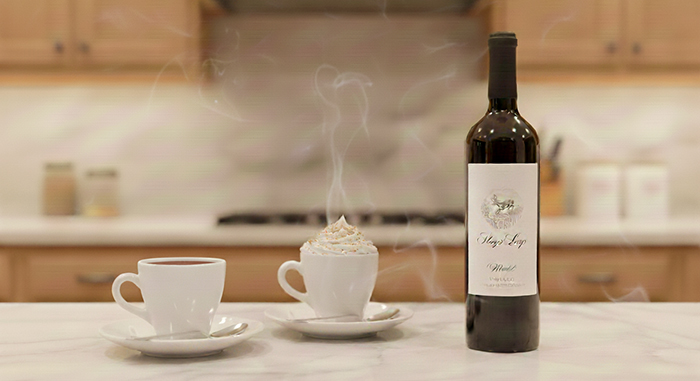 [7] We personally prefer whipped cream to marshmallows, but try it all three ways: whipped cream, toasted marshmallows, and no garnish (Abacus Photo). Preparation a. Stovetop Method 1. WHISK the chocolate chips, brown sugar, cocoa, cinnamon and salt together in a large saucepan or stockpot. Add the milk and bring to a low simmer over medium-low heat, whisking often. Once the hot chocolate is blended and smooth, about 8-10 minutes… 2. REDUCE to low heat and add the wine. Cook for 5 minutes more. Ladle the hot chocolate into mugs. b. Slow Cooker Method 1. WHISK the chocolate chips, brown sugar, cocoa, cinnamon, salt and milk together in a slow cooker set on high. Cover and allow to come to temperature (10-15 minutes), then whisk again and add the wine. 2. COOK on high for one hour, stopping to whisk every 20 minutes. Ladle the hot chocolate into mugs and top with whipped cream or marshmallows. The most famous region for growing the Merlot grape is the Médoc commune of the Bordeaux region of France, where it began. The Médoc devotes 40% of its planting space to Merlot grapes*, and Merlot is the third most-planted grape in France. It is used as both a blending grape and for varietal wines. Historically, vintners have used Merlot as a blending grape to soften a wine, usually with Cabernet Sauvignon It’s part of a classic Bordeaux blend. The earliest mention of Merlot is written in the notes of an official in Bordeaux, France in 1784. In his document, Merlot was spelled Merlau, and the official noted that the wine was among the best in the area. In the 1800s, the spelling Merlot appears. In 1824, an article on the region’s wine mentions that the Merlot grape was named after the local blackbird. Why? Today, beyond France, Merlot is planted in Argentina, Australia, Bulgaria, California, Chile, China, Hungary, Italy, Long Island (New York), New Zealand, South Africa, Spain and Switzerland. In the late 1990s, researchers at University of California-Davis found that Merlot is an offspring of Cabernet Franc, and is a half-sibling of Cabernet Sauvignon, Carménère and Malbec. But what grape was the “mother?” In the late 2000s, an obscure and unnamed grape variety, discovered growing in an abandoned vineyard in Saint-Suliac in Brittany, was shown by DNA analysis to be the mother of Merlot. It has since been formally registered under the name Magdeleine Noire des Charentes [source]. Merlot tannins are softer than those of Cabernet Sauvignon, so Merlot wine tends to mature earlier. In other words, you don’t have to let the bottle age as long. Merlot is known for its fruit flavors, with notes that can include blackberries, blackcurrants, dried cherries, plums and raspberries. Sometimes, there are also leafy/vegetal notes. Depending on the region in which the grapes are grown, there are spicy notes that can include bay leaf, black pepper, cloves and mint. Depending on whether the Merlot has been lightly or heavily oaked, it can have flavors of coconut and vanilla (in lightly oaked Merlots); or smoke, oak and tar (in heavily oaked Merlots). As the wine ages in the bottle, it can develop deeper flavors, such as coffee, earth, leather and tobacco. While Merlot is made across the globe, there tend to be two main styles. While some small-production, highly-rated wines can sell for up to $200 a bottle—or even thousands, as in the case of Château Petrus—there are numerous affordable bottles in the $20 range. Ask your wine clerk for a recommendation. The Merlot grape was brought to California in the mid-19th century. In the U.S., Merlot has become popular as a varietal wine (one that is largely composed of a single grape variety). Most of the Merlot vines in California are planted in Lodi/San Joaquin County, followed by Napa Valley, Monterey, and Sonoma counties. These are the locations locations where the terroir‡ is most conducive to producing the best Merlot grapes. Merlot wine reached its peak popularity in the U.S. during the 1990s. Then came the Merlot-bashing film “Sideways,” leading to a drop in the wine’s popularity [source]. But forget that little piece of “history”: If you haven’t been drinking California Merlot, get to know this friendly and delicious varietal. *The most planted grape used for Bordeaux wine from the Médoc is Cabernet Sauvignon, followed by Merlot, Cabernet Franc, Petit Verdot, Malbec and Carmenere [source]. †Technically the Gironde is an estuary: a partly enclosed coastal body of water with one or more rivers flowing into it, and then to the open sea (in this case, the Atlantic Ocean). ‡Terroir, pronounced tur-WAH, is a French agricultural term referring to the unique set of environmental factors in a specific habitat that affect a crop’s qualities. It includes climate, elevation, proximity to a body of water, slant of the land, soil type and amount of sun. These environmental characteristics gives a fruit or vegetable its unique character. ‡‡As of 2016, Chardonnay is the most planted wine variety at 29%, followed by Cabernet Sauvignon at 22%, Pinot Noir at 18%, Merlot at 14%, Zinfandel at 9% and Sauvignon Blanc at 4%. Note that 53% of the grapes harvested in California are for table grapes and raisins. CHECK OUT WHAT’S HAPPENING ON OUR HOME PAGE, THENIBBLE.COM. |
||
